ENH 712: Health Education & Diabetes Prevention in Older Adults
VerifiedAdded on 2023/05/30
|12
|4025
|130
Report
AI Summary
This report presents a health education program designed for Canadian First Nation older adults, addressing the critical issue of diabetes. It identifies diabetes, cardiovascular disorders, and cancer as major health concerns within this population, prioritizing diabetes due to its high prevalence and associated complications. The program's goal is to raise awareness, promote lifestyle changes, and encourage participation in screening programs. SMART objectives include reducing diabetes mortality and increasing screening rates. The program will be implemented in community centers and primary healthcare centers, featuring health education sessions, diabetes screening, and smoking/alcohol cessation programs. Key stakeholders include Diabetes Canada Association and Canadian doctors/nurses. The Health Belief Model and social cognitive theory guide the program's components, emphasizing risk assessment, consequence communication, action benefits, barrier reduction, and skill development. Success will be measured by increased participation and reduced mortality rates. Desklib offers a range of resources, including past papers and solved assignments, to support students in their academic endeavors.
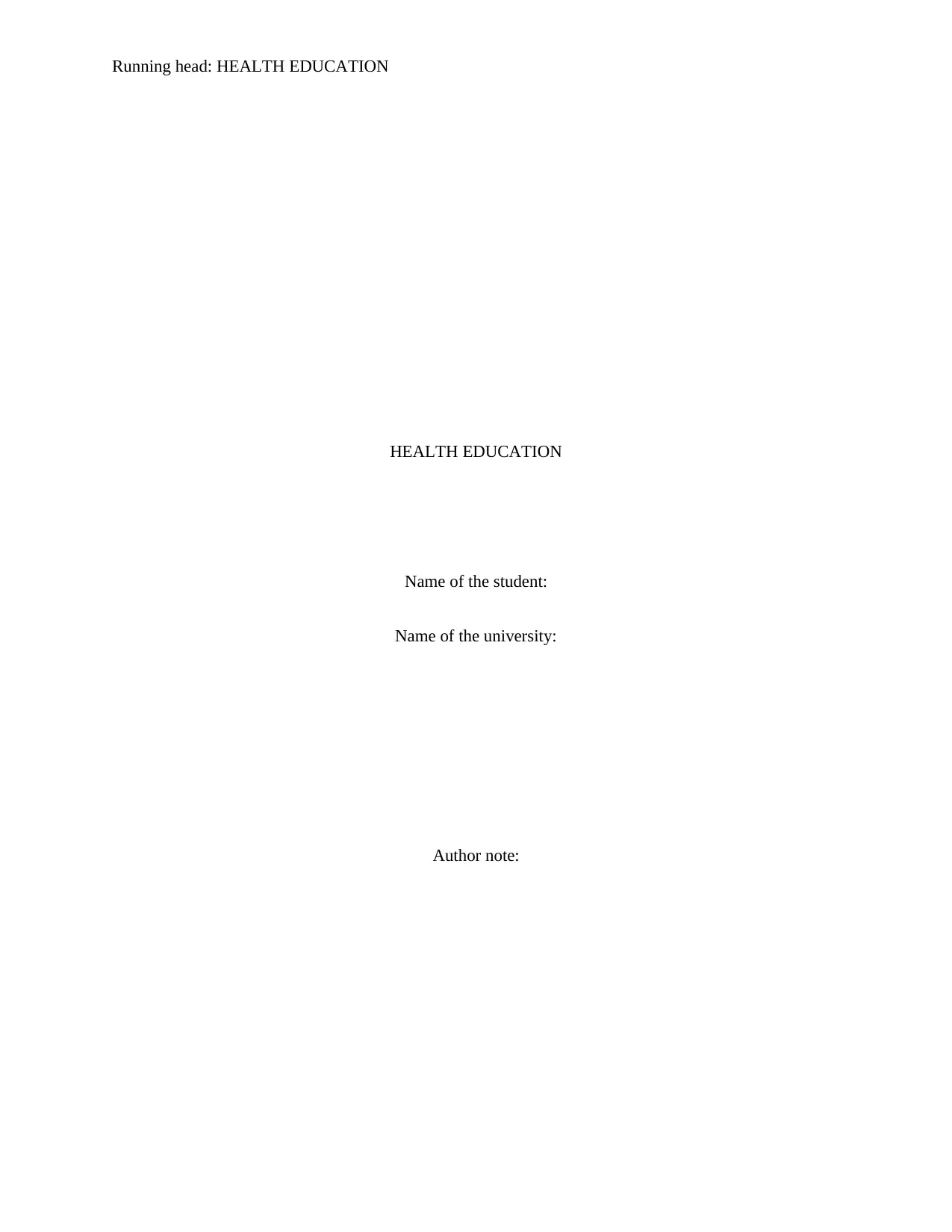
Running head: HEALTH EDUCATION
HEALTH EDUCATION
Name of the student:
Name of the university:
Author note:
HEALTH EDUCATION
Name of the student:
Name of the university:
Author note:
Paraphrase This Document
Need a fresh take? Get an instant paraphrase of this document with our AI Paraphraser
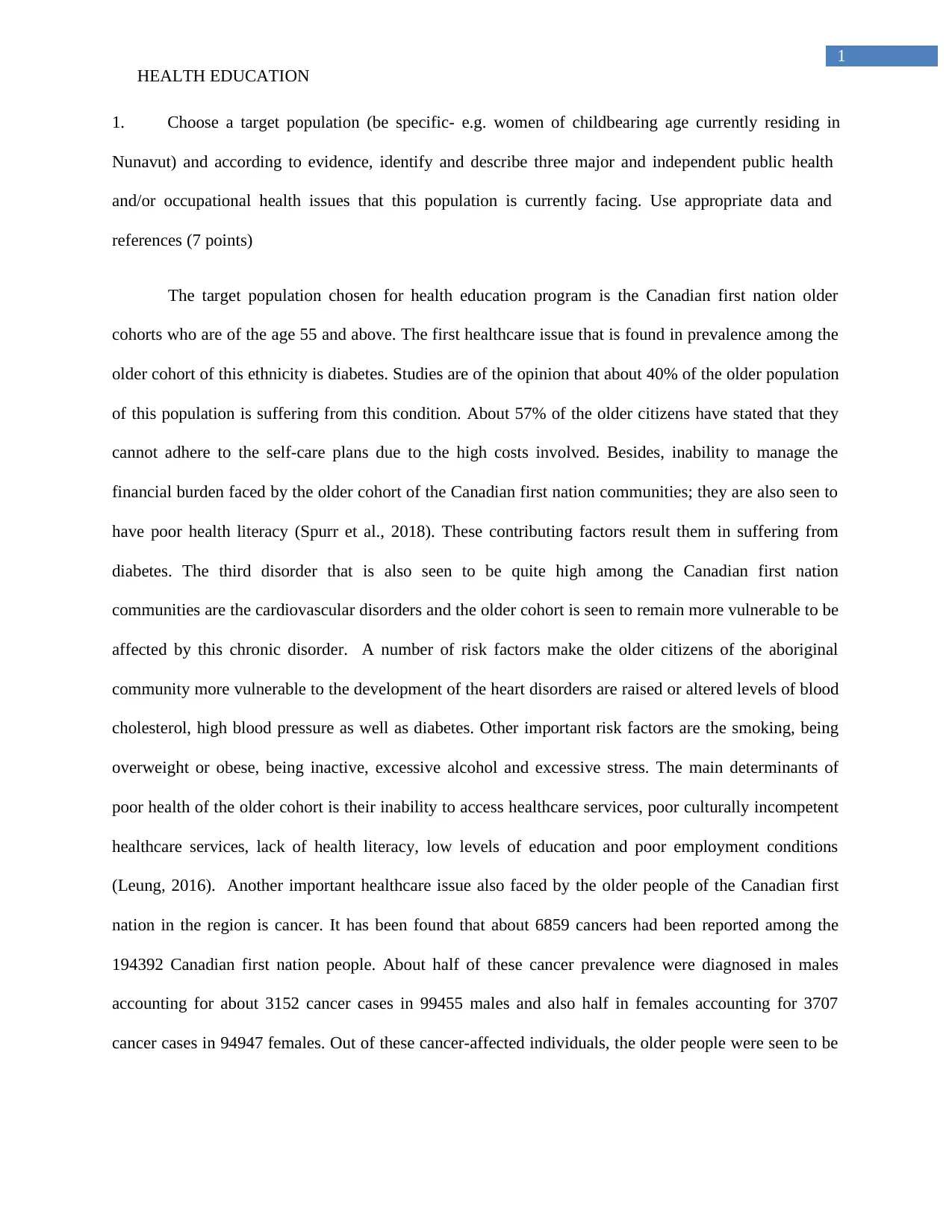
1
HEALTH EDUCATION
1. Choose a target population (be specific- e.g. women of childbearing age currently residing in
Nunavut) and according to evidence, identify and describe three major and independent public health
and/or occupational health issues that this population is currently facing. Use appropriate data and
references (7 points)
The target population chosen for health education program is the Canadian first nation older
cohorts who are of the age 55 and above. The first healthcare issue that is found in prevalence among the
older cohort of this ethnicity is diabetes. Studies are of the opinion that about 40% of the older population
of this population is suffering from this condition. About 57% of the older citizens have stated that they
cannot adhere to the self-care plans due to the high costs involved. Besides, inability to manage the
financial burden faced by the older cohort of the Canadian first nation communities; they are also seen to
have poor health literacy (Spurr et al., 2018). These contributing factors result them in suffering from
diabetes. The third disorder that is also seen to be quite high among the Canadian first nation
communities are the cardiovascular disorders and the older cohort is seen to remain more vulnerable to be
affected by this chronic disorder. A number of risk factors make the older citizens of the aboriginal
community more vulnerable to the development of the heart disorders are raised or altered levels of blood
cholesterol, high blood pressure as well as diabetes. Other important risk factors are the smoking, being
overweight or obese, being inactive, excessive alcohol and excessive stress. The main determinants of
poor health of the older cohort is their inability to access healthcare services, poor culturally incompetent
healthcare services, lack of health literacy, low levels of education and poor employment conditions
(Leung, 2016). Another important healthcare issue also faced by the older people of the Canadian first
nation in the region is cancer. It has been found that about 6859 cancers had been reported among the
194392 Canadian first nation people. About half of these cancer prevalence were diagnosed in males
accounting for about 3152 cancer cases in 99455 males and also half in females accounting for 3707
cancer cases in 94947 females. Out of these cancer-affected individuals, the older people were seen to be
HEALTH EDUCATION
1. Choose a target population (be specific- e.g. women of childbearing age currently residing in
Nunavut) and according to evidence, identify and describe three major and independent public health
and/or occupational health issues that this population is currently facing. Use appropriate data and
references (7 points)
The target population chosen for health education program is the Canadian first nation older
cohorts who are of the age 55 and above. The first healthcare issue that is found in prevalence among the
older cohort of this ethnicity is diabetes. Studies are of the opinion that about 40% of the older population
of this population is suffering from this condition. About 57% of the older citizens have stated that they
cannot adhere to the self-care plans due to the high costs involved. Besides, inability to manage the
financial burden faced by the older cohort of the Canadian first nation communities; they are also seen to
have poor health literacy (Spurr et al., 2018). These contributing factors result them in suffering from
diabetes. The third disorder that is also seen to be quite high among the Canadian first nation
communities are the cardiovascular disorders and the older cohort is seen to remain more vulnerable to be
affected by this chronic disorder. A number of risk factors make the older citizens of the aboriginal
community more vulnerable to the development of the heart disorders are raised or altered levels of blood
cholesterol, high blood pressure as well as diabetes. Other important risk factors are the smoking, being
overweight or obese, being inactive, excessive alcohol and excessive stress. The main determinants of
poor health of the older cohort is their inability to access healthcare services, poor culturally incompetent
healthcare services, lack of health literacy, low levels of education and poor employment conditions
(Leung, 2016). Another important healthcare issue also faced by the older people of the Canadian first
nation in the region is cancer. It has been found that about 6859 cancers had been reported among the
194392 Canadian first nation people. About half of these cancer prevalence were diagnosed in males
accounting for about 3152 cancer cases in 99455 males and also half in females accounting for 3707
cancer cases in 94947 females. Out of these cancer-affected individuals, the older people were seen to be
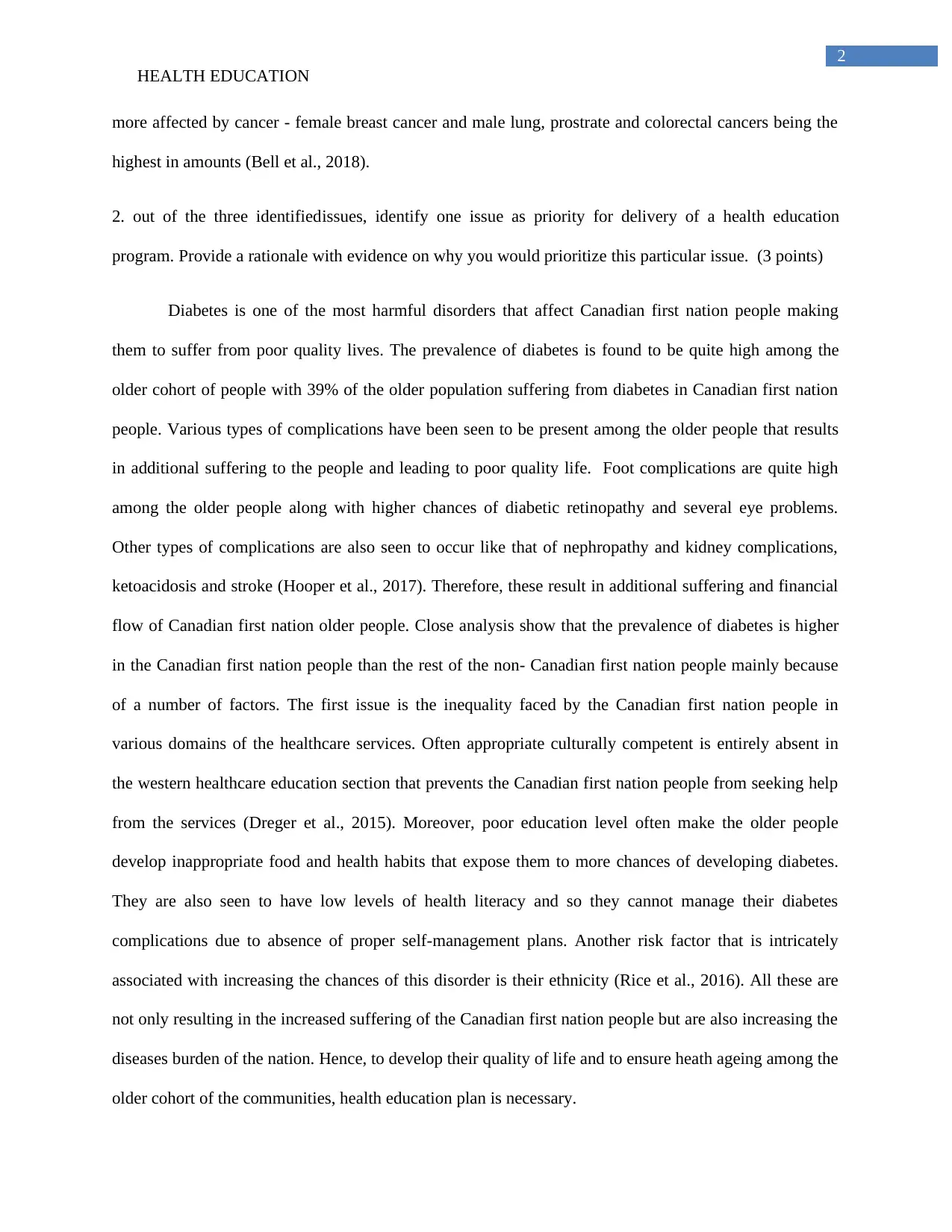
2
HEALTH EDUCATION
more affected by cancer - female breast cancer and male lung, prostrate and colorectal cancers being the
highest in amounts (Bell et al., 2018).
2. out of the three identifiedissues, identify one issue as priority for delivery of a health education
program. Provide a rationale with evidence on why you would prioritize this particular issue. (3 points)
Diabetes is one of the most harmful disorders that affect Canadian first nation people making
them to suffer from poor quality lives. The prevalence of diabetes is found to be quite high among the
older cohort of people with 39% of the older population suffering from diabetes in Canadian first nation
people. Various types of complications have been seen to be present among the older people that results
in additional suffering to the people and leading to poor quality life. Foot complications are quite high
among the older people along with higher chances of diabetic retinopathy and several eye problems.
Other types of complications are also seen to occur like that of nephropathy and kidney complications,
ketoacidosis and stroke (Hooper et al., 2017). Therefore, these result in additional suffering and financial
flow of Canadian first nation older people. Close analysis show that the prevalence of diabetes is higher
in the Canadian first nation people than the rest of the non- Canadian first nation people mainly because
of a number of factors. The first issue is the inequality faced by the Canadian first nation people in
various domains of the healthcare services. Often appropriate culturally competent is entirely absent in
the western healthcare education section that prevents the Canadian first nation people from seeking help
from the services (Dreger et al., 2015). Moreover, poor education level often make the older people
develop inappropriate food and health habits that expose them to more chances of developing diabetes.
They are also seen to have low levels of health literacy and so they cannot manage their diabetes
complications due to absence of proper self-management plans. Another risk factor that is intricately
associated with increasing the chances of this disorder is their ethnicity (Rice et al., 2016). All these are
not only resulting in the increased suffering of the Canadian first nation people but are also increasing the
diseases burden of the nation. Hence, to develop their quality of life and to ensure heath ageing among the
older cohort of the communities, health education plan is necessary.
HEALTH EDUCATION
more affected by cancer - female breast cancer and male lung, prostrate and colorectal cancers being the
highest in amounts (Bell et al., 2018).
2. out of the three identifiedissues, identify one issue as priority for delivery of a health education
program. Provide a rationale with evidence on why you would prioritize this particular issue. (3 points)
Diabetes is one of the most harmful disorders that affect Canadian first nation people making
them to suffer from poor quality lives. The prevalence of diabetes is found to be quite high among the
older cohort of people with 39% of the older population suffering from diabetes in Canadian first nation
people. Various types of complications have been seen to be present among the older people that results
in additional suffering to the people and leading to poor quality life. Foot complications are quite high
among the older people along with higher chances of diabetic retinopathy and several eye problems.
Other types of complications are also seen to occur like that of nephropathy and kidney complications,
ketoacidosis and stroke (Hooper et al., 2017). Therefore, these result in additional suffering and financial
flow of Canadian first nation older people. Close analysis show that the prevalence of diabetes is higher
in the Canadian first nation people than the rest of the non- Canadian first nation people mainly because
of a number of factors. The first issue is the inequality faced by the Canadian first nation people in
various domains of the healthcare services. Often appropriate culturally competent is entirely absent in
the western healthcare education section that prevents the Canadian first nation people from seeking help
from the services (Dreger et al., 2015). Moreover, poor education level often make the older people
develop inappropriate food and health habits that expose them to more chances of developing diabetes.
They are also seen to have low levels of health literacy and so they cannot manage their diabetes
complications due to absence of proper self-management plans. Another risk factor that is intricately
associated with increasing the chances of this disorder is their ethnicity (Rice et al., 2016). All these are
not only resulting in the increased suffering of the Canadian first nation people but are also increasing the
diseases burden of the nation. Hence, to develop their quality of life and to ensure heath ageing among the
older cohort of the communities, health education plan is necessary.
⊘ This is a preview!⊘
Do you want full access?
Subscribe today to unlock all pages.

Trusted by 1+ million students worldwide
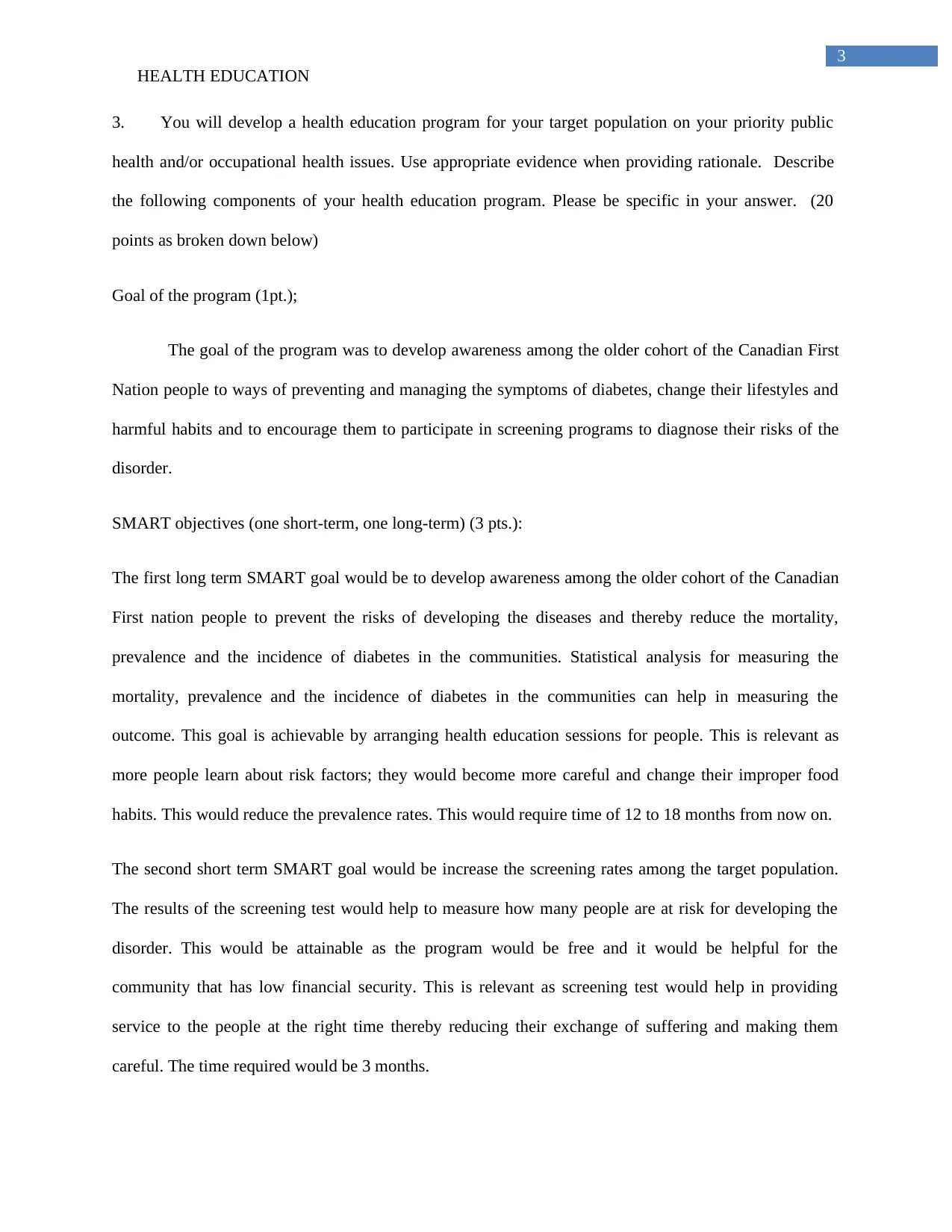
3
HEALTH EDUCATION
3. You will develop a health education program for your target population on your priority public
health and/or occupational health issues. Use appropriate evidence when providing rationale. Describe
the following components of your health education program. Please be specific in your answer. (20
points as broken down below)
Goal of the program (1pt.);
The goal of the program was to develop awareness among the older cohort of the Canadian First
Nation people to ways of preventing and managing the symptoms of diabetes, change their lifestyles and
harmful habits and to encourage them to participate in screening programs to diagnose their risks of the
disorder.
SMART objectives (one short-term, one long-term) (3 pts.):
The first long term SMART goal would be to develop awareness among the older cohort of the Canadian
First nation people to prevent the risks of developing the diseases and thereby reduce the mortality,
prevalence and the incidence of diabetes in the communities. Statistical analysis for measuring the
mortality, prevalence and the incidence of diabetes in the communities can help in measuring the
outcome. This goal is achievable by arranging health education sessions for people. This is relevant as
more people learn about risk factors; they would become more careful and change their improper food
habits. This would reduce the prevalence rates. This would require time of 12 to 18 months from now on.
The second short term SMART goal would be increase the screening rates among the target population.
The results of the screening test would help to measure how many people are at risk for developing the
disorder. This would be attainable as the program would be free and it would be helpful for the
community that has low financial security. This is relevant as screening test would help in providing
service to the people at the right time thereby reducing their exchange of suffering and making them
careful. The time required would be 3 months.
HEALTH EDUCATION
3. You will develop a health education program for your target population on your priority public
health and/or occupational health issues. Use appropriate evidence when providing rationale. Describe
the following components of your health education program. Please be specific in your answer. (20
points as broken down below)
Goal of the program (1pt.);
The goal of the program was to develop awareness among the older cohort of the Canadian First
Nation people to ways of preventing and managing the symptoms of diabetes, change their lifestyles and
harmful habits and to encourage them to participate in screening programs to diagnose their risks of the
disorder.
SMART objectives (one short-term, one long-term) (3 pts.):
The first long term SMART goal would be to develop awareness among the older cohort of the Canadian
First nation people to prevent the risks of developing the diseases and thereby reduce the mortality,
prevalence and the incidence of diabetes in the communities. Statistical analysis for measuring the
mortality, prevalence and the incidence of diabetes in the communities can help in measuring the
outcome. This goal is achievable by arranging health education sessions for people. This is relevant as
more people learn about risk factors; they would become more careful and change their improper food
habits. This would reduce the prevalence rates. This would require time of 12 to 18 months from now on.
The second short term SMART goal would be increase the screening rates among the target population.
The results of the screening test would help to measure how many people are at risk for developing the
disorder. This would be attainable as the program would be free and it would be helpful for the
community that has low financial security. This is relevant as screening test would help in providing
service to the people at the right time thereby reducing their exchange of suffering and making them
careful. The time required would be 3 months.
Paraphrase This Document
Need a fresh take? Get an instant paraphrase of this document with our AI Paraphraser
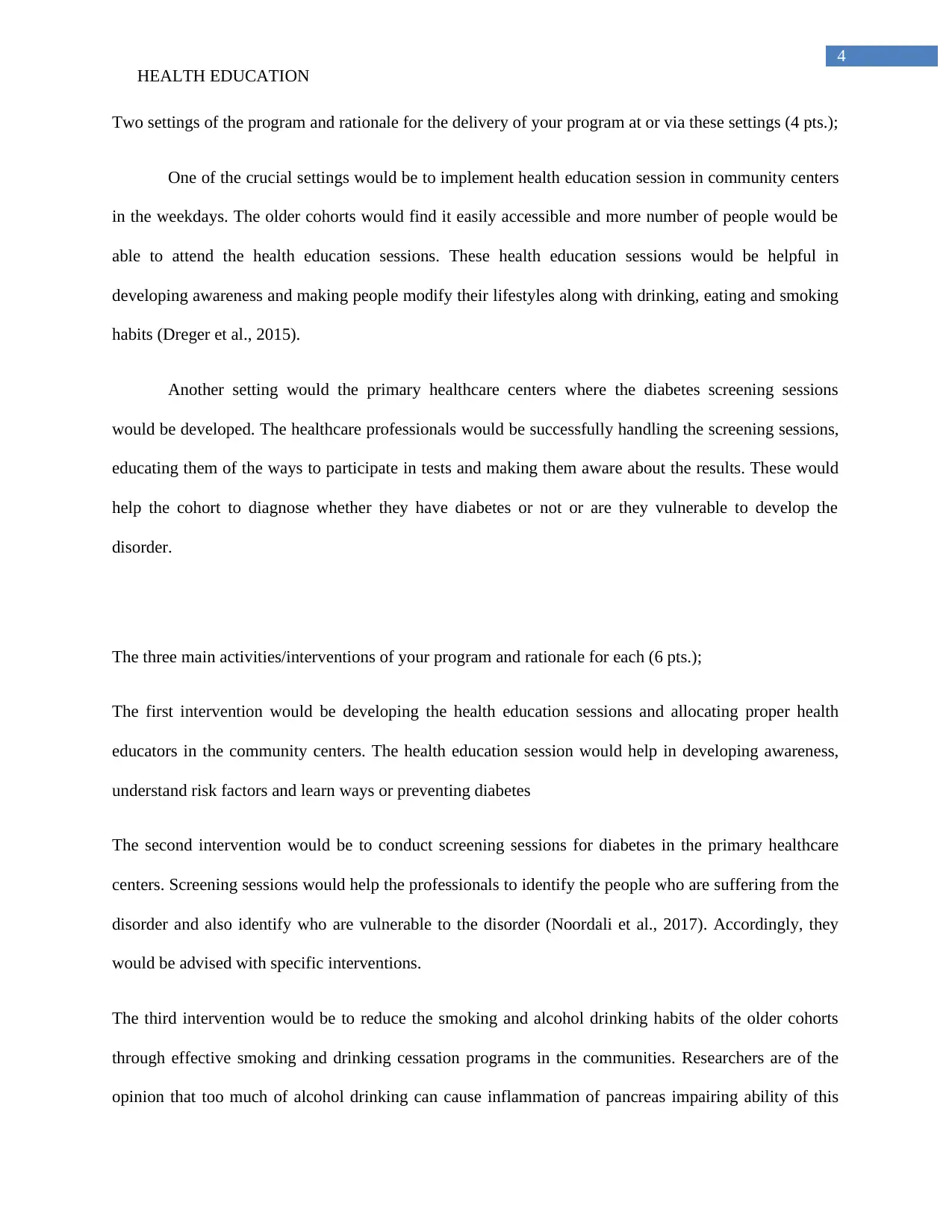
4
HEALTH EDUCATION
Two settings of the program and rationale for the delivery of your program at or via these settings (4 pts.);
One of the crucial settings would be to implement health education session in community centers
in the weekdays. The older cohorts would find it easily accessible and more number of people would be
able to attend the health education sessions. These health education sessions would be helpful in
developing awareness and making people modify their lifestyles along with drinking, eating and smoking
habits (Dreger et al., 2015).
Another setting would the primary healthcare centers where the diabetes screening sessions
would be developed. The healthcare professionals would be successfully handling the screening sessions,
educating them of the ways to participate in tests and making them aware about the results. These would
help the cohort to diagnose whether they have diabetes or not or are they vulnerable to develop the
disorder.
The three main activities/interventions of your program and rationale for each (6 pts.);
The first intervention would be developing the health education sessions and allocating proper health
educators in the community centers. The health education session would help in developing awareness,
understand risk factors and learn ways or preventing diabetes
The second intervention would be to conduct screening sessions for diabetes in the primary healthcare
centers. Screening sessions would help the professionals to identify the people who are suffering from the
disorder and also identify who are vulnerable to the disorder (Noordali et al., 2017). Accordingly, they
would be advised with specific interventions.
The third intervention would be to reduce the smoking and alcohol drinking habits of the older cohorts
through effective smoking and drinking cessation programs in the communities. Researchers are of the
opinion that too much of alcohol drinking can cause inflammation of pancreas impairing ability of this
HEALTH EDUCATION
Two settings of the program and rationale for the delivery of your program at or via these settings (4 pts.);
One of the crucial settings would be to implement health education session in community centers
in the weekdays. The older cohorts would find it easily accessible and more number of people would be
able to attend the health education sessions. These health education sessions would be helpful in
developing awareness and making people modify their lifestyles along with drinking, eating and smoking
habits (Dreger et al., 2015).
Another setting would the primary healthcare centers where the diabetes screening sessions
would be developed. The healthcare professionals would be successfully handling the screening sessions,
educating them of the ways to participate in tests and making them aware about the results. These would
help the cohort to diagnose whether they have diabetes or not or are they vulnerable to develop the
disorder.
The three main activities/interventions of your program and rationale for each (6 pts.);
The first intervention would be developing the health education sessions and allocating proper health
educators in the community centers. The health education session would help in developing awareness,
understand risk factors and learn ways or preventing diabetes
The second intervention would be to conduct screening sessions for diabetes in the primary healthcare
centers. Screening sessions would help the professionals to identify the people who are suffering from the
disorder and also identify who are vulnerable to the disorder (Noordali et al., 2017). Accordingly, they
would be advised with specific interventions.
The third intervention would be to reduce the smoking and alcohol drinking habits of the older cohorts
through effective smoking and drinking cessation programs in the communities. Researchers are of the
opinion that too much of alcohol drinking can cause inflammation of pancreas impairing ability of this
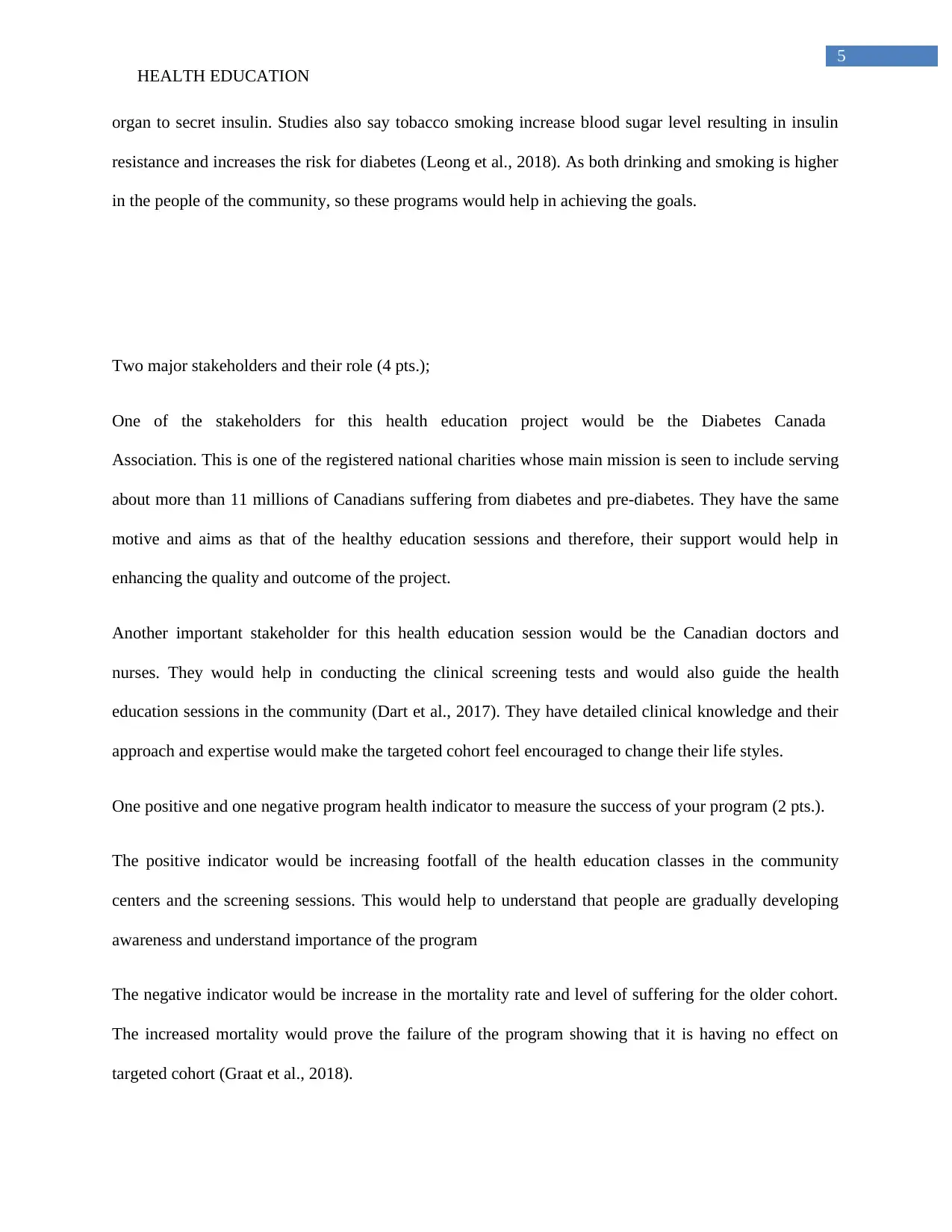
5
HEALTH EDUCATION
organ to secret insulin. Studies also say tobacco smoking increase blood sugar level resulting in insulin
resistance and increases the risk for diabetes (Leong et al., 2018). As both drinking and smoking is higher
in the people of the community, so these programs would help in achieving the goals.
Two major stakeholders and their role (4 pts.);
One of the stakeholders for this health education project would be the Diabetes Canada
Association. This is one of the registered national charities whose main mission is seen to include serving
about more than 11 millions of Canadians suffering from diabetes and pre-diabetes. They have the same
motive and aims as that of the healthy education sessions and therefore, their support would help in
enhancing the quality and outcome of the project.
Another important stakeholder for this health education session would be the Canadian doctors and
nurses. They would help in conducting the clinical screening tests and would also guide the health
education sessions in the community (Dart et al., 2017). They have detailed clinical knowledge and their
approach and expertise would make the targeted cohort feel encouraged to change their life styles.
One positive and one negative program health indicator to measure the success of your program (2 pts.).
The positive indicator would be increasing footfall of the health education classes in the community
centers and the screening sessions. This would help to understand that people are gradually developing
awareness and understand importance of the program
The negative indicator would be increase in the mortality rate and level of suffering for the older cohort.
The increased mortality would prove the failure of the program showing that it is having no effect on
targeted cohort (Graat et al., 2018).
HEALTH EDUCATION
organ to secret insulin. Studies also say tobacco smoking increase blood sugar level resulting in insulin
resistance and increases the risk for diabetes (Leong et al., 2018). As both drinking and smoking is higher
in the people of the community, so these programs would help in achieving the goals.
Two major stakeholders and their role (4 pts.);
One of the stakeholders for this health education project would be the Diabetes Canada
Association. This is one of the registered national charities whose main mission is seen to include serving
about more than 11 millions of Canadians suffering from diabetes and pre-diabetes. They have the same
motive and aims as that of the healthy education sessions and therefore, their support would help in
enhancing the quality and outcome of the project.
Another important stakeholder for this health education session would be the Canadian doctors and
nurses. They would help in conducting the clinical screening tests and would also guide the health
education sessions in the community (Dart et al., 2017). They have detailed clinical knowledge and their
approach and expertise would make the targeted cohort feel encouraged to change their life styles.
One positive and one negative program health indicator to measure the success of your program (2 pts.).
The positive indicator would be increasing footfall of the health education classes in the community
centers and the screening sessions. This would help to understand that people are gradually developing
awareness and understand importance of the program
The negative indicator would be increase in the mortality rate and level of suffering for the older cohort.
The increased mortality would prove the failure of the program showing that it is having no effect on
targeted cohort (Graat et al., 2018).
⊘ This is a preview!⊘
Do you want full access?
Subscribe today to unlock all pages.

Trusted by 1+ million students worldwide

6
HEALTH EDUCATION
4. State the underlying health education theory (or theories) and describe how the theory guides the
components of your program. Be specific. (5 points)
One of the most important health education theories that need to be followed is the Health Belief
model. This model is extremely useful for designing short and long term interventions and comprises of
five key actions related components. The components mainly determine the ability of the health belief
model for effective identification of the key decision making points, which influence the health behaviors
of people. Firstly, the model involves gathering of the information by conducting a proper health needs
assessments and inculcating efforts for proper determination of who is at risks and the population that
needs to be targeted (Harris et al., 2017). Secondly, it involves effective conveying of the consequences
of the health issues that remain intricately associated with the risky behaviors so that the targeted
population can understand the perceived severity. Third, the health educators would then be
communicating with the target population the important steps that would be involved in taking the
recommended actions and thereby highlighting the benefits to the action. Fourth, the health educators
need to provide assistance in proper identification as well as reduction of the barriers to the action. Fifth,
the educators would be demonstrating important actions through different types of skill development
activities and would also provide the support to the targeted population by enhancing self-efficacy and the
likelihood of the successful health behavior modifications. The health education plan should also instill
components of the social cognitive theory. This theory mainly helps in describing the influence of the
individual experiences as well as the actions of others and the impact of the environmental factors in the
individual health behaviors. Some of the key components that are related with individual behavior
changes include self-efficacy. This component is the belief that an individual had control over and is able
to execute a proper behavior (Doyle et al., 2018). Another component is the behavioral capability that is
the ability of the targeted individual to understand and possess the skill to perform a particular behavior.
Another component is the expectations, which involves determination of the outcomes of the behaviors
HEALTH EDUCATION
4. State the underlying health education theory (or theories) and describe how the theory guides the
components of your program. Be specific. (5 points)
One of the most important health education theories that need to be followed is the Health Belief
model. This model is extremely useful for designing short and long term interventions and comprises of
five key actions related components. The components mainly determine the ability of the health belief
model for effective identification of the key decision making points, which influence the health behaviors
of people. Firstly, the model involves gathering of the information by conducting a proper health needs
assessments and inculcating efforts for proper determination of who is at risks and the population that
needs to be targeted (Harris et al., 2017). Secondly, it involves effective conveying of the consequences
of the health issues that remain intricately associated with the risky behaviors so that the targeted
population can understand the perceived severity. Third, the health educators would then be
communicating with the target population the important steps that would be involved in taking the
recommended actions and thereby highlighting the benefits to the action. Fourth, the health educators
need to provide assistance in proper identification as well as reduction of the barriers to the action. Fifth,
the educators would be demonstrating important actions through different types of skill development
activities and would also provide the support to the targeted population by enhancing self-efficacy and the
likelihood of the successful health behavior modifications. The health education plan should also instill
components of the social cognitive theory. This theory mainly helps in describing the influence of the
individual experiences as well as the actions of others and the impact of the environmental factors in the
individual health behaviors. Some of the key components that are related with individual behavior
changes include self-efficacy. This component is the belief that an individual had control over and is able
to execute a proper behavior (Doyle et al., 2018). Another component is the behavioral capability that is
the ability of the targeted individual to understand and possess the skill to perform a particular behavior.
Another component is the expectations, which involves determination of the outcomes of the behaviors
Paraphrase This Document
Need a fresh take? Get an instant paraphrase of this document with our AI Paraphraser
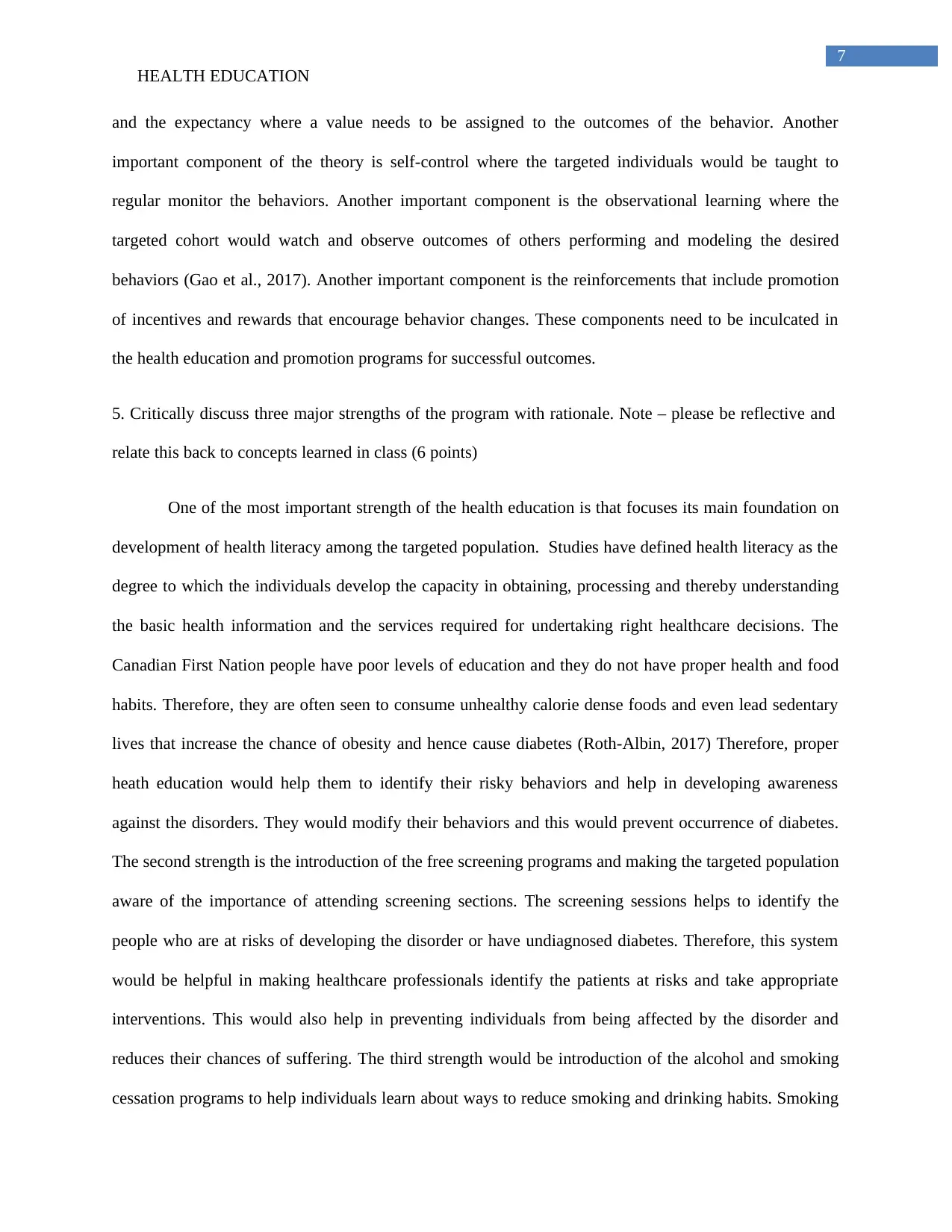
7
HEALTH EDUCATION
and the expectancy where a value needs to be assigned to the outcomes of the behavior. Another
important component of the theory is self-control where the targeted individuals would be taught to
regular monitor the behaviors. Another important component is the observational learning where the
targeted cohort would watch and observe outcomes of others performing and modeling the desired
behaviors (Gao et al., 2017). Another important component is the reinforcements that include promotion
of incentives and rewards that encourage behavior changes. These components need to be inculcated in
the health education and promotion programs for successful outcomes.
5. Critically discuss three major strengths of the program with rationale. Note – please be reflective and
relate this back to concepts learned in class (6 points)
One of the most important strength of the health education is that focuses its main foundation on
development of health literacy among the targeted population. Studies have defined health literacy as the
degree to which the individuals develop the capacity in obtaining, processing and thereby understanding
the basic health information and the services required for undertaking right healthcare decisions. The
Canadian First Nation people have poor levels of education and they do not have proper health and food
habits. Therefore, they are often seen to consume unhealthy calorie dense foods and even lead sedentary
lives that increase the chance of obesity and hence cause diabetes (Roth-Albin, 2017) Therefore, proper
heath education would help them to identify their risky behaviors and help in developing awareness
against the disorders. They would modify their behaviors and this would prevent occurrence of diabetes.
The second strength is the introduction of the free screening programs and making the targeted population
aware of the importance of attending screening sections. The screening sessions helps to identify the
people who are at risks of developing the disorder or have undiagnosed diabetes. Therefore, this system
would be helpful in making healthcare professionals identify the patients at risks and take appropriate
interventions. This would also help in preventing individuals from being affected by the disorder and
reduces their chances of suffering. The third strength would be introduction of the alcohol and smoking
cessation programs to help individuals learn about ways to reduce smoking and drinking habits. Smoking
HEALTH EDUCATION
and the expectancy where a value needs to be assigned to the outcomes of the behavior. Another
important component of the theory is self-control where the targeted individuals would be taught to
regular monitor the behaviors. Another important component is the observational learning where the
targeted cohort would watch and observe outcomes of others performing and modeling the desired
behaviors (Gao et al., 2017). Another important component is the reinforcements that include promotion
of incentives and rewards that encourage behavior changes. These components need to be inculcated in
the health education and promotion programs for successful outcomes.
5. Critically discuss three major strengths of the program with rationale. Note – please be reflective and
relate this back to concepts learned in class (6 points)
One of the most important strength of the health education is that focuses its main foundation on
development of health literacy among the targeted population. Studies have defined health literacy as the
degree to which the individuals develop the capacity in obtaining, processing and thereby understanding
the basic health information and the services required for undertaking right healthcare decisions. The
Canadian First Nation people have poor levels of education and they do not have proper health and food
habits. Therefore, they are often seen to consume unhealthy calorie dense foods and even lead sedentary
lives that increase the chance of obesity and hence cause diabetes (Roth-Albin, 2017) Therefore, proper
heath education would help them to identify their risky behaviors and help in developing awareness
against the disorders. They would modify their behaviors and this would prevent occurrence of diabetes.
The second strength is the introduction of the free screening programs and making the targeted population
aware of the importance of attending screening sections. The screening sessions helps to identify the
people who are at risks of developing the disorder or have undiagnosed diabetes. Therefore, this system
would be helpful in making healthcare professionals identify the patients at risks and take appropriate
interventions. This would also help in preventing individuals from being affected by the disorder and
reduces their chances of suffering. The third strength would be introduction of the alcohol and smoking
cessation programs to help individuals learn about ways to reduce smoking and drinking habits. Smoking
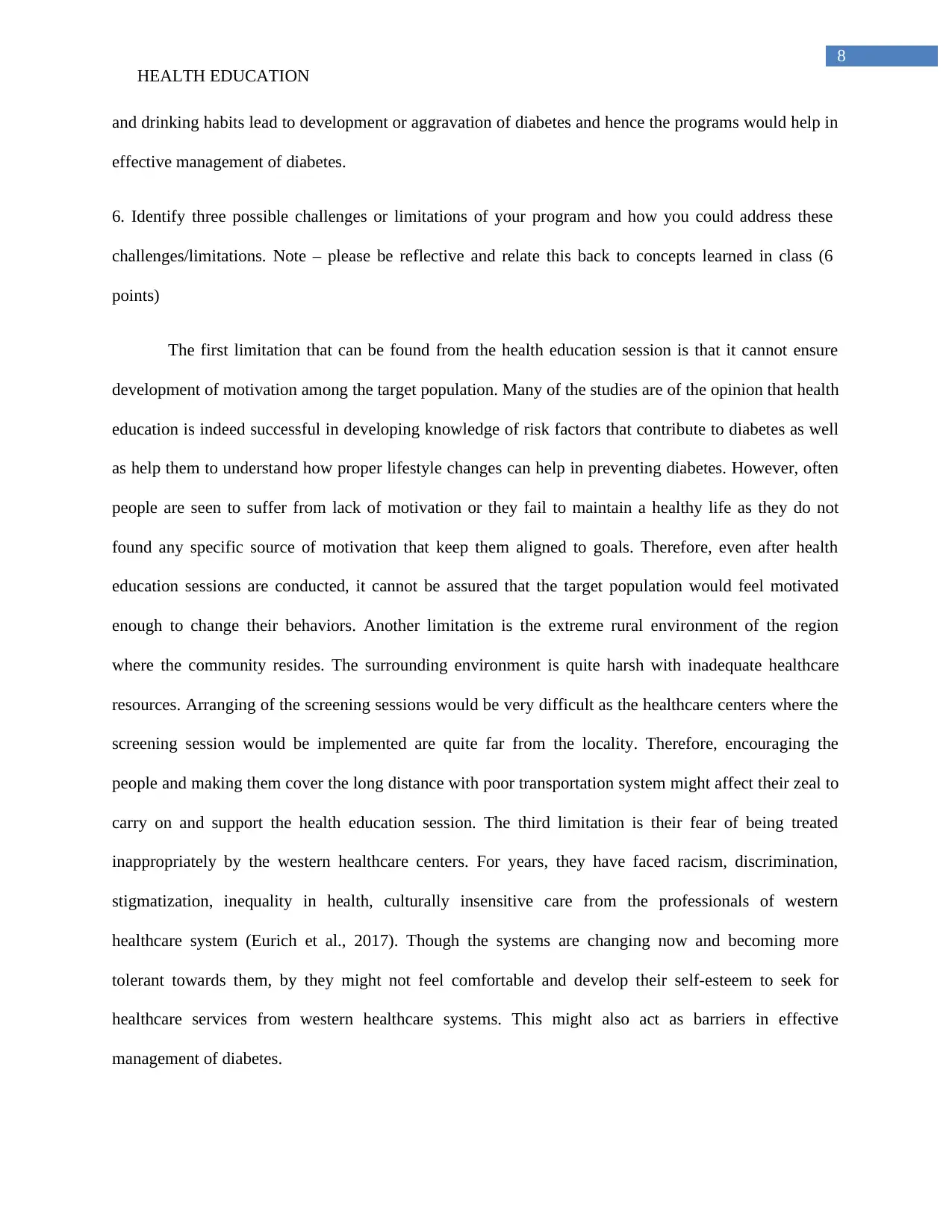
8
HEALTH EDUCATION
and drinking habits lead to development or aggravation of diabetes and hence the programs would help in
effective management of diabetes.
6. Identify three possible challenges or limitations of your program and how you could address these
challenges/limitations. Note – please be reflective and relate this back to concepts learned in class (6
points)
The first limitation that can be found from the health education session is that it cannot ensure
development of motivation among the target population. Many of the studies are of the opinion that health
education is indeed successful in developing knowledge of risk factors that contribute to diabetes as well
as help them to understand how proper lifestyle changes can help in preventing diabetes. However, often
people are seen to suffer from lack of motivation or they fail to maintain a healthy life as they do not
found any specific source of motivation that keep them aligned to goals. Therefore, even after health
education sessions are conducted, it cannot be assured that the target population would feel motivated
enough to change their behaviors. Another limitation is the extreme rural environment of the region
where the community resides. The surrounding environment is quite harsh with inadequate healthcare
resources. Arranging of the screening sessions would be very difficult as the healthcare centers where the
screening session would be implemented are quite far from the locality. Therefore, encouraging the
people and making them cover the long distance with poor transportation system might affect their zeal to
carry on and support the health education session. The third limitation is their fear of being treated
inappropriately by the western healthcare centers. For years, they have faced racism, discrimination,
stigmatization, inequality in health, culturally insensitive care from the professionals of western
healthcare system (Eurich et al., 2017). Though the systems are changing now and becoming more
tolerant towards them, by they might not feel comfortable and develop their self-esteem to seek for
healthcare services from western healthcare systems. This might also act as barriers in effective
management of diabetes.
HEALTH EDUCATION
and drinking habits lead to development or aggravation of diabetes and hence the programs would help in
effective management of diabetes.
6. Identify three possible challenges or limitations of your program and how you could address these
challenges/limitations. Note – please be reflective and relate this back to concepts learned in class (6
points)
The first limitation that can be found from the health education session is that it cannot ensure
development of motivation among the target population. Many of the studies are of the opinion that health
education is indeed successful in developing knowledge of risk factors that contribute to diabetes as well
as help them to understand how proper lifestyle changes can help in preventing diabetes. However, often
people are seen to suffer from lack of motivation or they fail to maintain a healthy life as they do not
found any specific source of motivation that keep them aligned to goals. Therefore, even after health
education sessions are conducted, it cannot be assured that the target population would feel motivated
enough to change their behaviors. Another limitation is the extreme rural environment of the region
where the community resides. The surrounding environment is quite harsh with inadequate healthcare
resources. Arranging of the screening sessions would be very difficult as the healthcare centers where the
screening session would be implemented are quite far from the locality. Therefore, encouraging the
people and making them cover the long distance with poor transportation system might affect their zeal to
carry on and support the health education session. The third limitation is their fear of being treated
inappropriately by the western healthcare centers. For years, they have faced racism, discrimination,
stigmatization, inequality in health, culturally insensitive care from the professionals of western
healthcare system (Eurich et al., 2017). Though the systems are changing now and becoming more
tolerant towards them, by they might not feel comfortable and develop their self-esteem to seek for
healthcare services from western healthcare systems. This might also act as barriers in effective
management of diabetes.
⊘ This is a preview!⊘
Do you want full access?
Subscribe today to unlock all pages.

Trusted by 1+ million students worldwide
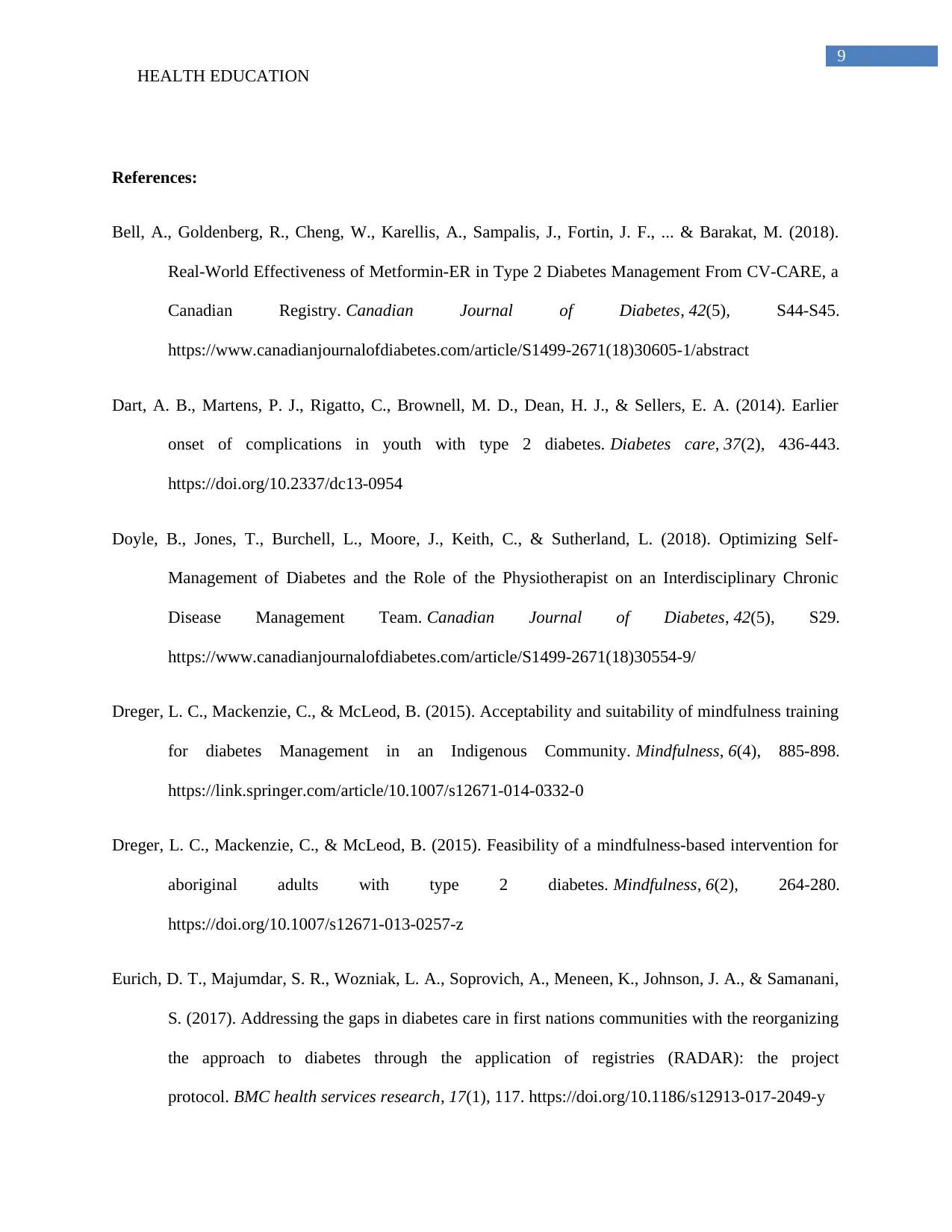
9
HEALTH EDUCATION
References:
Bell, A., Goldenberg, R., Cheng, W., Karellis, A., Sampalis, J., Fortin, J. F., ... & Barakat, M. (2018).
Real-World Effectiveness of Metformin-ER in Type 2 Diabetes Management From CV-CARE, a
Canadian Registry. Canadian Journal of Diabetes, 42(5), S44-S45.
https://www.canadianjournalofdiabetes.com/article/S1499-2671(18)30605-1/abstract
Dart, A. B., Martens, P. J., Rigatto, C., Brownell, M. D., Dean, H. J., & Sellers, E. A. (2014). Earlier
onset of complications in youth with type 2 diabetes. Diabetes care, 37(2), 436-443.
https://doi.org/10.2337/dc13-0954
Doyle, B., Jones, T., Burchell, L., Moore, J., Keith, C., & Sutherland, L. (2018). Optimizing Self-
Management of Diabetes and the Role of the Physiotherapist on an Interdisciplinary Chronic
Disease Management Team. Canadian Journal of Diabetes, 42(5), S29.
https://www.canadianjournalofdiabetes.com/article/S1499-2671(18)30554-9/
Dreger, L. C., Mackenzie, C., & McLeod, B. (2015). Acceptability and suitability of mindfulness training
for diabetes Management in an Indigenous Community. Mindfulness, 6(4), 885-898.
https://link.springer.com/article/10.1007/s12671-014-0332-0
Dreger, L. C., Mackenzie, C., & McLeod, B. (2015). Feasibility of a mindfulness-based intervention for
aboriginal adults with type 2 diabetes. Mindfulness, 6(2), 264-280.
https://doi.org/10.1007/s12671-013-0257-z
Eurich, D. T., Majumdar, S. R., Wozniak, L. A., Soprovich, A., Meneen, K., Johnson, J. A., & Samanani,
S. (2017). Addressing the gaps in diabetes care in first nations communities with the reorganizing
the approach to diabetes through the application of registries (RADAR): the project
protocol. BMC health services research, 17(1), 117. https://doi.org/10.1186/s12913-017-2049-y
HEALTH EDUCATION
References:
Bell, A., Goldenberg, R., Cheng, W., Karellis, A., Sampalis, J., Fortin, J. F., ... & Barakat, M. (2018).
Real-World Effectiveness of Metformin-ER in Type 2 Diabetes Management From CV-CARE, a
Canadian Registry. Canadian Journal of Diabetes, 42(5), S44-S45.
https://www.canadianjournalofdiabetes.com/article/S1499-2671(18)30605-1/abstract
Dart, A. B., Martens, P. J., Rigatto, C., Brownell, M. D., Dean, H. J., & Sellers, E. A. (2014). Earlier
onset of complications in youth with type 2 diabetes. Diabetes care, 37(2), 436-443.
https://doi.org/10.2337/dc13-0954
Doyle, B., Jones, T., Burchell, L., Moore, J., Keith, C., & Sutherland, L. (2018). Optimizing Self-
Management of Diabetes and the Role of the Physiotherapist on an Interdisciplinary Chronic
Disease Management Team. Canadian Journal of Diabetes, 42(5), S29.
https://www.canadianjournalofdiabetes.com/article/S1499-2671(18)30554-9/
Dreger, L. C., Mackenzie, C., & McLeod, B. (2015). Acceptability and suitability of mindfulness training
for diabetes Management in an Indigenous Community. Mindfulness, 6(4), 885-898.
https://link.springer.com/article/10.1007/s12671-014-0332-0
Dreger, L. C., Mackenzie, C., & McLeod, B. (2015). Feasibility of a mindfulness-based intervention for
aboriginal adults with type 2 diabetes. Mindfulness, 6(2), 264-280.
https://doi.org/10.1007/s12671-013-0257-z
Eurich, D. T., Majumdar, S. R., Wozniak, L. A., Soprovich, A., Meneen, K., Johnson, J. A., & Samanani,
S. (2017). Addressing the gaps in diabetes care in first nations communities with the reorganizing
the approach to diabetes through the application of registries (RADAR): the project
protocol. BMC health services research, 17(1), 117. https://doi.org/10.1186/s12913-017-2049-y
Paraphrase This Document
Need a fresh take? Get an instant paraphrase of this document with our AI Paraphraser
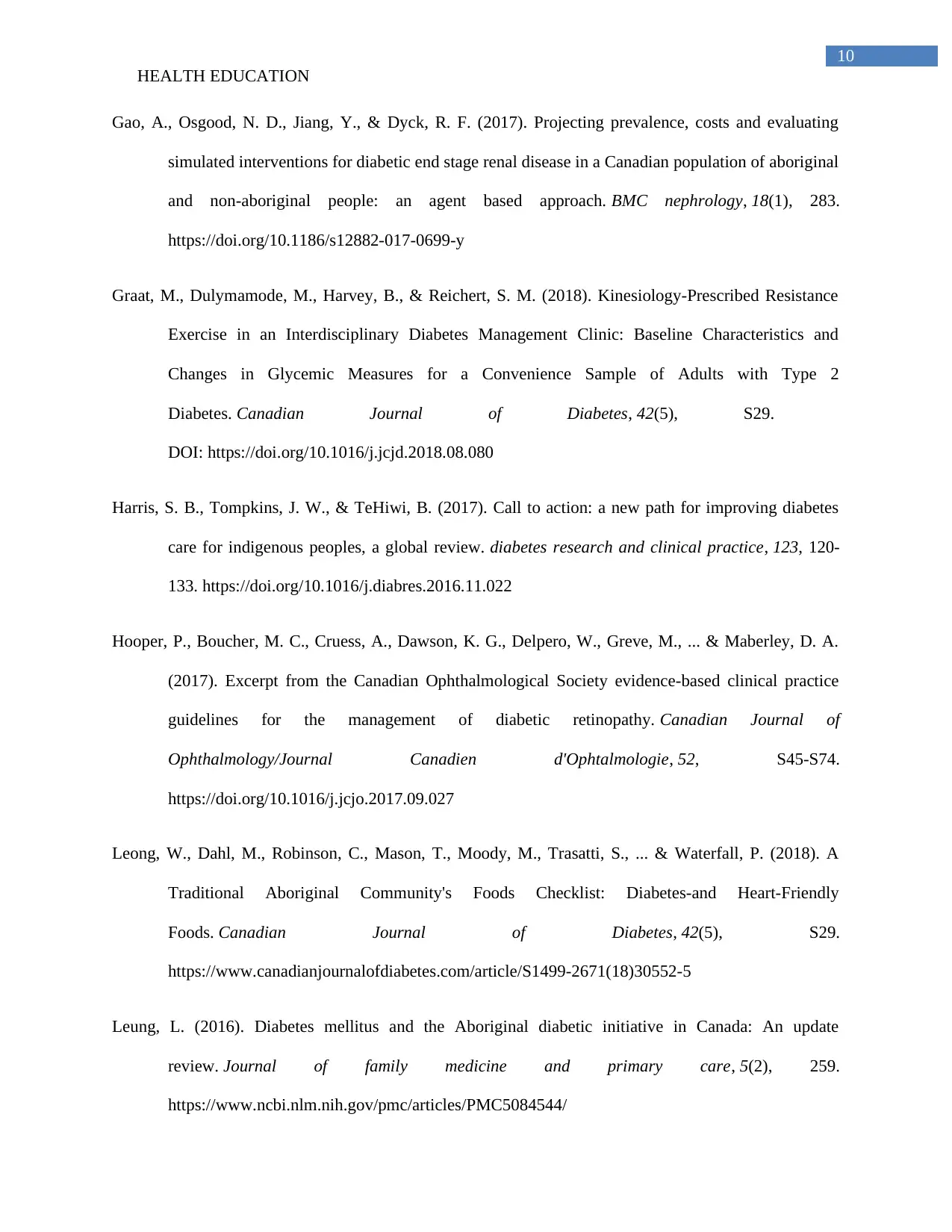
10
HEALTH EDUCATION
Gao, A., Osgood, N. D., Jiang, Y., & Dyck, R. F. (2017). Projecting prevalence, costs and evaluating
simulated interventions for diabetic end stage renal disease in a Canadian population of aboriginal
and non-aboriginal people: an agent based approach. BMC nephrology, 18(1), 283.
https://doi.org/10.1186/s12882-017-0699-y
Graat, M., Dulymamode, M., Harvey, B., & Reichert, S. M. (2018). Kinesiology-Prescribed Resistance
Exercise in an Interdisciplinary Diabetes Management Clinic: Baseline Characteristics and
Changes in Glycemic Measures for a Convenience Sample of Adults with Type 2
Diabetes. Canadian Journal of Diabetes, 42(5), S29.
DOI: https://doi.org/10.1016/j.jcjd.2018.08.080
Harris, S. B., Tompkins, J. W., & TeHiwi, B. (2017). Call to action: a new path for improving diabetes
care for indigenous peoples, a global review. diabetes research and clinical practice, 123, 120-
133. https://doi.org/10.1016/j.diabres.2016.11.022
Hooper, P., Boucher, M. C., Cruess, A., Dawson, K. G., Delpero, W., Greve, M., ... & Maberley, D. A.
(2017). Excerpt from the Canadian Ophthalmological Society evidence-based clinical practice
guidelines for the management of diabetic retinopathy. Canadian Journal of
Ophthalmology/Journal Canadien d'Ophtalmologie, 52, S45-S74.
https://doi.org/10.1016/j.jcjo.2017.09.027
Leong, W., Dahl, M., Robinson, C., Mason, T., Moody, M., Trasatti, S., ... & Waterfall, P. (2018). A
Traditional Aboriginal Community's Foods Checklist: Diabetes-and Heart-Friendly
Foods. Canadian Journal of Diabetes, 42(5), S29.
https://www.canadianjournalofdiabetes.com/article/S1499-2671(18)30552-5
Leung, L. (2016). Diabetes mellitus and the Aboriginal diabetic initiative in Canada: An update
review. Journal of family medicine and primary care, 5(2), 259.
https://www.ncbi.nlm.nih.gov/pmc/articles/PMC5084544/
HEALTH EDUCATION
Gao, A., Osgood, N. D., Jiang, Y., & Dyck, R. F. (2017). Projecting prevalence, costs and evaluating
simulated interventions for diabetic end stage renal disease in a Canadian population of aboriginal
and non-aboriginal people: an agent based approach. BMC nephrology, 18(1), 283.
https://doi.org/10.1186/s12882-017-0699-y
Graat, M., Dulymamode, M., Harvey, B., & Reichert, S. M. (2018). Kinesiology-Prescribed Resistance
Exercise in an Interdisciplinary Diabetes Management Clinic: Baseline Characteristics and
Changes in Glycemic Measures for a Convenience Sample of Adults with Type 2
Diabetes. Canadian Journal of Diabetes, 42(5), S29.
DOI: https://doi.org/10.1016/j.jcjd.2018.08.080
Harris, S. B., Tompkins, J. W., & TeHiwi, B. (2017). Call to action: a new path for improving diabetes
care for indigenous peoples, a global review. diabetes research and clinical practice, 123, 120-
133. https://doi.org/10.1016/j.diabres.2016.11.022
Hooper, P., Boucher, M. C., Cruess, A., Dawson, K. G., Delpero, W., Greve, M., ... & Maberley, D. A.
(2017). Excerpt from the Canadian Ophthalmological Society evidence-based clinical practice
guidelines for the management of diabetic retinopathy. Canadian Journal of
Ophthalmology/Journal Canadien d'Ophtalmologie, 52, S45-S74.
https://doi.org/10.1016/j.jcjo.2017.09.027
Leong, W., Dahl, M., Robinson, C., Mason, T., Moody, M., Trasatti, S., ... & Waterfall, P. (2018). A
Traditional Aboriginal Community's Foods Checklist: Diabetes-and Heart-Friendly
Foods. Canadian Journal of Diabetes, 42(5), S29.
https://www.canadianjournalofdiabetes.com/article/S1499-2671(18)30552-5
Leung, L. (2016). Diabetes mellitus and the Aboriginal diabetic initiative in Canada: An update
review. Journal of family medicine and primary care, 5(2), 259.
https://www.ncbi.nlm.nih.gov/pmc/articles/PMC5084544/

11
HEALTH EDUCATION
Noordali, F., Cumming, J., & Thompson, J. L. (2017). Effectiveness of mindfulness-based interventions
on physiological and psychological complications in adults with diabetes: a systematic
review. Journal of health psychology, 22(8), 965-983.
https://doi.org/10.1177/1359105315620293
Rice, K., Te Hiwi, B, Zwarenstein, M., Lavallee, B., Barre, D. E., & Harris, S. B. (2016). Best practices
for the prevention and management of diabetes and obesity-related chronic disease among
Indigenous peoples in Canada: a review. Canadian journal of diabetes, 40(3), 216-225.
https://doi.org/10.1016/j.jcjd.2015.10.007.
Roth-Albin, I., Mai, S. H., Ahmed, Z., Cheng, J., Choong, K., & Mayer, P. V. (2017). Outcomes
following advanced wound care for diabetic foot ulcers: a Canadian study. Canadian journal of
diabetes, 41(1), 26-32. https://doi.org/10.1016/j.jcjd.2016.06.007
Spurr, S., Bullin, C., Bally, J., Trinder, K., & Khan, S. (2018). Nurse-led diabetic retinopathy screening: a
pilot study to evaluate a new approach to vision care for Canadian Aboriginal
peoples. International journal of circumpolar health, 77(1), 1422670.
https://doi.org/10.1080/22423982.2017.1422670
HEALTH EDUCATION
Noordali, F., Cumming, J., & Thompson, J. L. (2017). Effectiveness of mindfulness-based interventions
on physiological and psychological complications in adults with diabetes: a systematic
review. Journal of health psychology, 22(8), 965-983.
https://doi.org/10.1177/1359105315620293
Rice, K., Te Hiwi, B, Zwarenstein, M., Lavallee, B., Barre, D. E., & Harris, S. B. (2016). Best practices
for the prevention and management of diabetes and obesity-related chronic disease among
Indigenous peoples in Canada: a review. Canadian journal of diabetes, 40(3), 216-225.
https://doi.org/10.1016/j.jcjd.2015.10.007.
Roth-Albin, I., Mai, S. H., Ahmed, Z., Cheng, J., Choong, K., & Mayer, P. V. (2017). Outcomes
following advanced wound care for diabetic foot ulcers: a Canadian study. Canadian journal of
diabetes, 41(1), 26-32. https://doi.org/10.1016/j.jcjd.2016.06.007
Spurr, S., Bullin, C., Bally, J., Trinder, K., & Khan, S. (2018). Nurse-led diabetic retinopathy screening: a
pilot study to evaluate a new approach to vision care for Canadian Aboriginal
peoples. International journal of circumpolar health, 77(1), 1422670.
https://doi.org/10.1080/22423982.2017.1422670
⊘ This is a preview!⊘
Do you want full access?
Subscribe today to unlock all pages.

Trusted by 1+ million students worldwide
1 out of 12
Related Documents
Your All-in-One AI-Powered Toolkit for Academic Success.
+13062052269
info@desklib.com
Available 24*7 on WhatsApp / Email
![[object Object]](/_next/static/media/star-bottom.7253800d.svg)
Unlock your academic potential
Copyright © 2020–2025 A2Z Services. All Rights Reserved. Developed and managed by ZUCOL.





